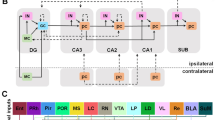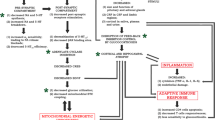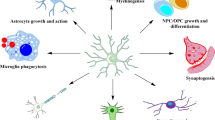Abstract
Olfactory dysfunction is often accompanied with anxiety- and depressive-like behaviors in depressive patients. Impaired neurogenesis in hippocampus and subventricular zone (SVZ)-olfactory bulb (OB) contribute to anxiety- and depressive-like behaviors and olfactory dysfunctions. However, the underlying mechanisms of olfactory dysfunction remain unclear. Our previous study indicates that adaptor protein, phosphotyrosine interacting with PH domain and leucine zipper 2 (APPL2), could affect the activity and sensitivity of glucocorticoid receptor (GR) and mediate impaired hippocampal neurogenesis, which contribute the development of depression. In the present study, we further identified the roles of APPL2 in olfactory functions. APPL2 Tg mice displayed higher GR activity and less capacity of neurogenesis at olfactory system with less olfactory sensitivity than WT mice, indicating that APPL2 could be a potential therapeutic target for depression and olfactory deficits. We then studied the effects of baicalin, a medicinal herbal compound, on modulating APPL2/GR signaling pathway for promoting neurogenesis and antidepressant as well as improving olfactory functions. Baicalin treatment inhibited APPL2/GR signaling pathway and improved neurogenesis at SVZ, OB, and hippocampus in APPL2 Tg mice and chronic corticosterone-induced depression mouse model. Behavioral tests revealed that baicalin attenuated depressive- and anxiety-like behaviors and improve olfactory functions in the chronic depression mouse model and APPL2 Tg mice. Taken together, APPL2 could be a novel therapeutic target for improving depressant-related olfactory dysfunctions and baicalin could inhibit APPL2-mediated GR hyperactivity and promote adult neurogenesis, subsequently releasing depressive and anxiety symptoms and improving olfactory functions for antidepressant therapy.







Similar content being viewed by others
References
Kessler RC, Berglund P, Demler O, Jin R, Merikangas KR, Walters EE (2005) Lifetime prevalence and age-of-onset distributions of DSM-IV disorders in the National Comorbidity Survey Replication. Arch Gen Psychiatry 62(6):593–602
Croy I, Negoias S, Symmank A, Schellong J, Joraschky P, Hummel T (2013) Reduced olfactory bulb volume in adults with a history of childhood maltreatment. Chem Senses 38(8):679–684
Clepce M, Gossler A, Reich K, Kornhuber J, Thuerauf N (2010) The relation between depression, anhedonia and olfactory hedonic estimates—a pilot study in major depression. Neurosci Lett 471(3):139–143
Gusmao ID, Monteiro BM, Cornelio GO, Fonseca CS, Moraes MF, Pereira GS (2012) Odor-enriched environment rescues long-term social memory, but does not improve olfaction in social isolated adult mice. Behav Brain Res 228(2):440–446
Fenton EY, Fournier NM, Lussier AL, Romay-Tallon R, Caruncho HJ, Kalynchuk LE (2015) Imipramine protects against the deleterious effects of chronic corticosterone on depression-like behavior, hippocampal reelin expression, and neuronal maturation. Prog Neuro-Psychopharmacol Biol Psychiatry 60:52–59
Kohman RA, Rhodes JS (2017) The contribution of adult hippocampal neurogenesis to the progression of psychiatric disorders. Mod Trends Pharmacopsychiatry 31:124–151
Eisch AJ, Petrik D (2012) Depression and hippocampal neurogenesis: a road to remission? Science 338(6103):72–75
Whitman MC, Greer CA (2009) Adult neurogenesis and the olfactory system. Prog Neurobiol 89(2):162–175
Schloesser RJ, Orvoen S, Jimenez DV, Hardy NF, Maynard KR, Sukumar M, Manji HK, Gardier AM et al (2015) Antidepressant-like effects of electroconvulsive seizures require adult neurogenesis in a neuroendocrine model of depression. Brain Stimul 8(5):862–867
Santarelli L et al (2003) Requirement of hippocampal neurogenesis for the behavioral effects of antidepressants. Science 301(5634):805–809
Gregus A, Wintink AJ, Davis AC, Kalynchuk LE (2005) Effect of repeated corticosterone injections and restraint stress on anxiety and depression-like behavior in male rats. Behav Brain Res 156(1):105–114
Siopi E et al (2016) Anxiety- and depression-like states lead to pronounced olfactory deficits and impaired adult neurogenesis in mice. J Neurosci 36(2):518–531
Altar CA (1999) Neurotrophins and depression. Trends Pharmacol Sci 20(2):59–61
Egeland M, Zunszain PA, Pariante CM (2015) Molecular mechanisms in the regulation of adult neurogenesis during stress. Nat Rev Neurosci 16(4):189–200
Anacker C et al (2013) Role for the kinase SGK1 in stress, depression, and glucocorticoid effects on hippocampal neurogenesis. Proc Natl Acad Sci U S A 110(21):8708–8713
Gao C, Wang Q, Chung SK, Shen J (2017) Crosstalk of metabolic factors and neurogenic signaling in adult neurogenesis: Implication of metabolic regulation for mental and neurological diseases. Neurochem Int 106:24–36
Moon HS, Dincer F, Mantzoros CS (2013) Amylin-induced downregulation of hippocampal neurogenesis is attenuated by leptin in a STAT3/AMPK/ERK-dependent manner in mice. Diabetologia 56(3):627–634
Carlson SW, Madathil SK, Sama DM, Gao X, Chen J, Saatman KE (2014) Conditional overexpression of insulin-like growth factor-1 enhances hippocampal neurogenesis and restores immature neuron dendritic processes after traumatic brain injury. J Neuropathol Exp Neurol 73(8):734–746
Zhang D, Wang X, Lu XY (2016) Adiponectin exerts neurotrophic effects on dendritic arborization, spinogenesis, and neurogenesis of the dentate gyrus of male mice. Endocrinology 157(7):2853–2869
Cheng KK et al (2014) The adaptor protein APPL2 inhibits insulin-stimulated glucose uptake by interacting with TBC1D1 in skeletal muscle. Diabetes 63(11):3748–3758
Gao C, Chen X, Xu A, Cheng K, Shen J (2017) Adaptor protein APPL2 affects adult antidepressant behaviors and hippocampal neurogenesis via regulating the sensitivity of glucocorticoid receptor. Mol Neurobiol. https://doi.org/10.1007/s12035-017-0785-y
Li BQ, Fu T, Gong WH, Dunlop N, Kung HF, Yan Y, Kang J, Wang JM (2000) The flavonoid baicalin exhibits anti-inflammatory activity by binding to chemokines. Immunopharmacology 49(3):295–306
Hwang JM, Wang CJ, Chou FP, Tseng TH, Hsieh YS, Hsu JD, Chu CY (2005) Protective effect of baicalin on tert-butyl hydroperoxide-induced rat hepatotoxicity. Arch Toxicol 79(2):102–109
Jung SH, Kang KD, Ji D, Fawcett RJ, Safa R, Kamalden TA, Osborne NN (2008) The flavonoid baicalin counteracts ischemic and oxidative insults to retinal cells and lipid peroxidation to brain membranes. Neurochem Int 53(6–8):325–337
Li Y, Zhuang P, Shen B, Zhang Y, Shen J (2012) Baicalin promotes neuronal differentiation of neural stem/progenitor cells through modulating p-stat3 and bHLH family protein expression. Brain Res 1429:36–42
Li YC, Shen JD, Li J, Wang R, Jiao S, Yi LT (2013) Chronic treatment with baicalin prevents the chronic mild stress-induced depressive-like behavior: involving the inhibition of cyclooxygenase-2 in rat brain. Prog Neuro-Psychopharmacol Biol Psychiatry 40:138–143
Li YC et al (2015) Baicalin decreases SGK1 expression in the hippocampus and reverses depressive-like behaviors induced by corticosterone. Neuroscience 311:130–137
Alvarez-Buylla A, Garcia-Verdugo JM (2002) Neurogenesis in adult subventricular zone. J Neurosci 22(3):629–634
Brummelte S, Galea LA (2010) Chronic high corticosterone reduces neurogenesis in the dentate gyrus of adult male and female rats. Neuroscience 168(3):680–690
Lledo PM, Valley M (2016) Adult olfactory bulb neurogenesis. Cold Spring Harb Perspect Biol 8(8):a018945
Sequerra EB (2014) Subventricular zone progenitors in time and space: generating neuronal diversity. Front Cell Neurosci 8:434
Yuan TF, Slotnick BM (2014) Roles of olfactory system dysfunction in depression. Prog Neuro-Psychopharmacol Biol Psychiatry 54:26–30
Tsuno N, Besset A, Ritchie K (2005) Sleep and depression. J Clin Psychiatry 66(10):1254–1269
Lauer CJ, Krieg JC, Riemann D, Zulley J, Berger M (1990) A polysomnographic study in young psychiatric inpatients: major depression, anorexia nervosa, bulimia nervosa. J Affect Disord 18(4):235–245
Li Q et al (2015) Reduced amount of olfactory receptor neurons in the rat model of depression. Neurosci Lett 603:48–54
Zhang K et al (2016) Baicalin promotes hippocampal neurogenesis via SGK1- and FKBP5-mediated glucocorticoid receptor phosphorylation in a neuroendocrine mouse model of anxiety/depression. Sci Rep 6:30951
Acknowledgements
We truly appreciate the technology supports of Dr. Guo Jing and Mr. Jacky HUNG in Core facility HKU, the technology on dSTORM and Imaris software processing.
Funding
This work was supported by RGC GRF grants from Hong Kong Research Grants Council (GRF No. 777313M, 776512M, J.S.), RGC AoE/P-705/16, and Contract Research Grant with Beijing Tong Ren Tang Chinese Medicine Co., LTd.
Author information
Authors and Affiliations
Corresponding author
Ethics declarations
Conflicts of Interest
The authors declare that there are no conflicts of interest in this study.
Electronic supplementary material
ESM 1
(DOCX 3178 kb)
Rights and permissions
About this article
Cite this article
Gao, C., Du, Q., Li, W. et al. Baicalin Modulates APPL2/Glucocorticoid Receptor Signaling Cascade, Promotes Neurogenesis, and Attenuates Emotional and Olfactory Dysfunctions in Chronic Corticosterone-Induced Depression. Mol Neurobiol 55, 9334–9348 (2018). https://doi.org/10.1007/s12035-018-1042-8
Received:
Accepted:
Published:
Issue Date:
DOI: https://doi.org/10.1007/s12035-018-1042-8




